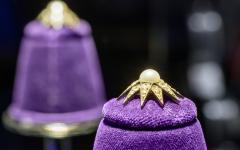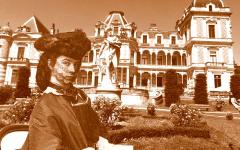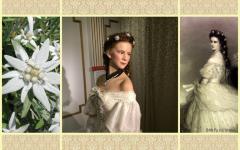WELL-KNOWN THEORIES ARE REFUTED BY THE SISI MUSEUM
During her lifetime, there was not as much interest shown towards Empress Elisabeth of Austria as nowadays. She gained popularity several decades after her tragic death. As Katrin Unterreiner says “there has hardly ever been a monarch stylised posthumously to such iconic status as Empress Elisabeth”. She “did not become an international marketed product with romanticised biography and entwined by legend until long after her death".
It was not only her violent death but also Ernst Marischka’s 1950s Sissi trilogy, which surrounded her by the aura of a myth. It made the Empress become well-known worldwide. However, the figure of the young Romy Schneider “molds the image of a young, sweet, easy-going” young woman, who has little in common with the real Empress Elisabeth (Katrin Unterreiner). The Exhibition of the Sisi Museum makes a successful attempt to introduce the real Sisi (Spelling: Sisi or Sissi?) while enlightening how the young and enthusiastic girl turns “into somebody so frustrated” who would rather be dead.
Elisabeth by Georg Raab, 1867 © Schloß Schönbrunn Kultur- und Betriebsges.m.b.H.

On display at the Sisi Museum there are more than 300 items including parasols, fans and gloves that once belonged to Elisabeth, along with her cosmetics recipes, a reconstruction of the Hungarian coronation gown worn in the famous photo series of Emil Rabending, her travelling medicine chest and jewellery, the actual file used to murder her, the black cloak with which the Empress was covered following her assassination and her death mask. Many of the exhibits derive from what was formerly the largest collection of personal effects belonging to Elisabeth in private hands.
The exhibition shows the main events of the Empress’s life by providing a lot of information along with her personal belongings. Besides, as referred above, some well-known theories are refuted in connection with Elisabeth, including the theory about her bad teeth and the fact that she wore only black gowns after her only-son, Rudolf’s death.
Room “At court” with detailed costume reconstructions. Sisi Museum © Schloß Schönbrunn Kultur- und Betriebsges.m.b.H./Lois Lammerhuber

Firstly, let us discuss the first theory. Elisabeth was said to have very bad teeth, many still believe that she even wore denture as an elderly woman, however, historians did not support this theory, what is more, some new findings state the very opposite. In the museum, we can have a look at the “dentistry hygiene set” which was only used for treating Elisabeth’s teeth. The hygiene of her teeth was highly important to Elisabeth so she visited her dentist, Raimund Günther von Kronmyrth at least twice a year, sometimes she dropped in without having made an appointment. As mentioned above, the beautiful, young Romy Schneider made Elisabeth well-known worldwide, however, quite ironically, it was her (Romy’s) grandmother (from her father’s side), Rosa Albach Retty, a former actress, who “started the rumour that one afternoon she had seen a slim woman in the Zauner pastry shop in Bad Ischl, dressed in black and instantly recognisable as Empress Elisabeth, surreptitiously cleaning her false teeth in a glass of water.” (Unterreiner, 71) However, there are many sources which state the opposite, that is, the Empress’ teeth were in a very good condition except their yellow colour, which was the result of smoking and her treatment with mercury to cure an illness. One may not know that Elisabeth’s smoked, sometimes even in open carriage so as to annoy her mother-in-law. An undoubtedly supporting evidence of her good teeth is her autopsy report (after her violent death her body was anatomized). Another evidence is her medical report: Every little thing in connection with her health was recorded, even the stretch marks (striae) on her belly, which were caused by the pregnancy. Her dental treatments were recorded as well, and there are no references to a denture or false teeth.
Vienna Hofburg, Sisi Museum: Reconstruction of the evening dress worn by the 16-year-old Sisi © Schloß Schönbrunn Kultur- und Betriebsges.m.b.H./Lois Lammerhuber

Another well-known theory is in connection with her wardrobe. Many Sisi-lovers know that the Empress refused to wear colourful dresses after the Crown Prince’s death and made only two exceptions (the wedding of Marie Valerie and the baptism ceremony of Valerie’s first child, Elisabeth). However, there are two colourful silk dresses (a blue one from c. 1895 and a rose colour one from c. 1890) on display worn by Elisabeth in the 1890’s. Both dresses, which were accidentally found in an auction (Munich, 2012), were worn by Sisi in Corfu, which is outside the border of the Austro-Hungarian Monarchy. That is, she sometimes liked to wear colourful gowns in countries where she was not well-known. Why did Sisi like to wear black dresses? Did they only express her grief over Rudolf’s death? Find out more here: The Ageing Empress.
For many centuries, the Vienna Hofburg was the centre of the Habsburg Empire. Today three museum attractions provide visitors with historically authentic insights into court tradition and daily life: the Imperial Apartments with their historically authentic decoration and furnishings, the Imperial Silver Collection with its extensive holdings of objects that recreate the sumptuous world of imperial dining (Read more: Invited to dinner by Emperor Franz Joseph), and the Sisi Museum with its lyrical exploration of the Empress’s life. (The Sisi Museum celebrated its tenth anniversary in 2014.)
Visit the exhibition of the Hofburg. Click the photo below.
Empress Elisabeth on Facebook!
The Life of Empress Elisabeth in Paintings and Drawings (1837-1898)
MAGYARUL: SISI – MÍTOSZ ÉS VALÓSÁG. Sisi Múzeum, Bécs
Works Cited
Katrin Unterreiner: Sisi - Myth and Truth
Olivia Lichtscheidl-Michael Wohlfart: Elisabeth. Empress and Queen. Schloß Schönbrunn Kultur- und Betriebsges.m.b.H. Ausztria, Bécs, 2016
Ingrid Haslinger - Olivia Lichtscheidl - Michael Wohlfart: The Residence of Empress Elisabeth. Imperial Apartments, Sisi Museum, Imperial Silver Collection. Schloß Schönbrunn Kultur- und Betriebsges.m.b.H.



